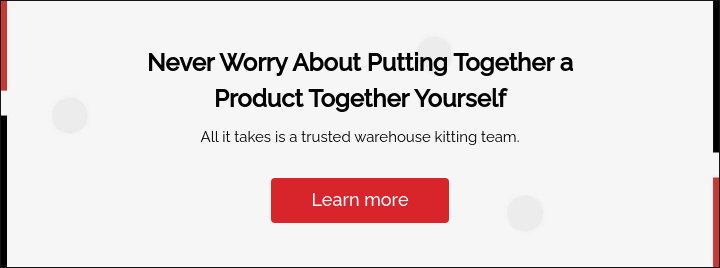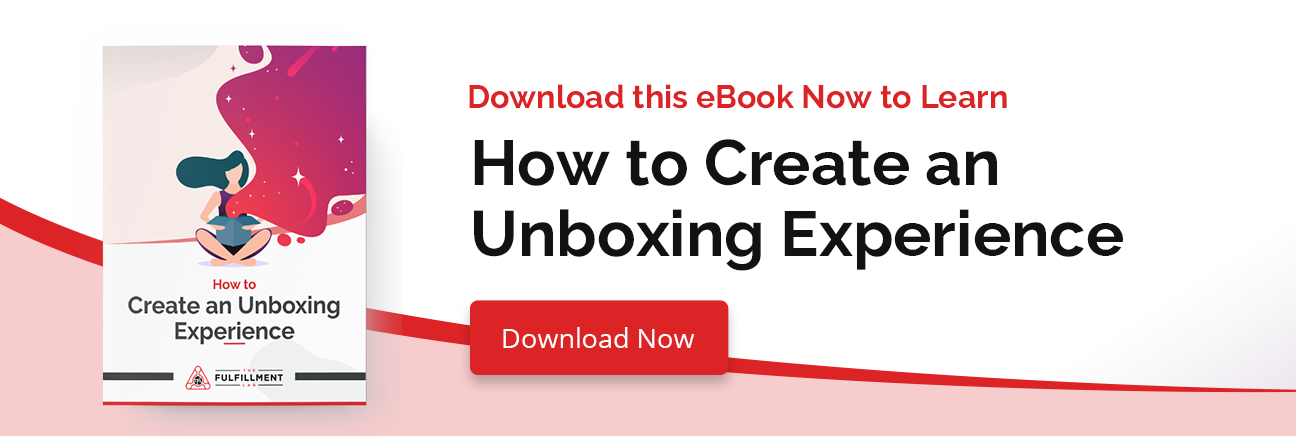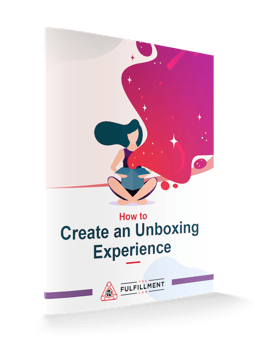12 Types of Custom Packaging for Ecommerce Business
Sometimes, it’s not just what’s on the inside that counts! When it comes to making a connection with your customers, it’s important to consider the type of packaging you ship your products in. The right exterior packaging can increase the perceived value of your product and show customers that you care about a quality presentation.
That’s not all; good product packaging has even led to a slew of “unboxing videos,” in which people post videos on social media highlighting their excitement over receiving a particularly well-packaged product (check out YouTube’s top 15 unboxing channels here). Who knows? With the right packaging, your product could be the star of the next viral video!
In the meantime, here are 12 types of packaging you may want to consider when it’s time to ship, and how your warehouse kitting team chooses the right packaging, every time.
1. Corrugated Boxes
Corrugated boxes are better known as cardboard; it’s what you’d expect to find your new pair of Nike sneakers inside of. This is the most used form of transport packaging, with about 95% of North American consumer goods being shipped inside of them. It’s important to know that there are different types of corrugated cardboard that impact the durability and strength of the box. The types are differentiated by their “flutes,” which are those waves you may see in some cardboard material (flutes are found between liner boards, which are glued on top and on bottom).
Generally, the larger the size of the flute, the better the cushioning and compression resistance. You’ll want to be sure the product you’re shipping is appropriate for the flute size in the corrugated box you’re using. It’s also not uncommon to find a corrugated box using multiple levels of flutes to strengthen the box.
2. Paperboard Boxes
Lightweight yet tough, paperboard boxes are folding carton boxes that lay flat when not in use. They can also easily be cut and manipulated to create custom shapes and structures. If you have the time, this can add a nice touch of personalization to your packaging. There are several types of paperboard boxes to consider:
- Solid bleached sulfate (SBS) boxes. These paperboard boxes have a brilliant white color due to their clay-coated surface and are excellent for custom-printed packages because the top ply of bleached virgin hardwood fibers makes them particularly smooth. SBS boxes are generally the choice for perishables, including frozen and wet foods, meats, dairy, bakery items, medical products, and cosmetics.
- Coated unbleached kraft (CUK) boxes. More environmentally friendly but also less resistant to moisture, CUK boxes appeal to customers who prefer the natural look of recycled material. The long, large pine fibers used to create the box provide excellent strength, making CUK boxes ideal for heavy items such as soft drinks, beer, laundry detergents, and hardware. Want to know more about green packaging options? Check out this blog by the Green Business Bureau.
- Coated recycled paperboard. This paperboard is made of recycled fibers but still used a clay coating to improve print performance. This type of box is often chosen by eCommerce retailers selling paper products and dry foods such as pasta and cereal.
- Chipboard paperboard. Chipboard is paperboard made from reclaimed stock. It’s cost-effective, but because it is so lightweight, it can’t be used for heavy items. Chipboard material can easily weaken in storage environments with high moisture levels, causing them to expand and become discolored.
3. Paper Bags
"Paper or plastic?" When it comes to the former, it's quick, easy, cheap, and customizable, so what's not to love? Paper bags have long been used for packaging for these reasons, which is also why they're a staple at most grocery stores. Plus, paper is viewed more positively when compared to plastic by the eco-friendly crowd, allowing businesses to highlight their environmental appeal.
4. Rigid Boxes
This type of branded packaging is used by many luxury names. It comes at a price, of course, and so do the items you’ll normally find inside—examples include Tiffany & Co. jewelry, Jimmy Choo shoes, and the latest iPhones.
What makes these boxes so special? Rigid boxes are made out of highly condensed paperboard, making it four times thicker than standard paperboard. They’re also designed not to be collapsible, which makes them more expensive to use and ship.
While small eCommerce businesses may not be ready for the expense of a rigid box, it’s certainly something to aspire toward!
5. Bottle & Cap
Shipping personal care products such as cosmetics, lotions, or creams? Perhaps you're focused on pharmaceuticals. Either way, "bottle & cap" packaging is the way to go. Not only do they offer manufacturer and end-user convenience, but they're also affordable when purchased in bulk. The right fulfillment center can also customize the bottle labeling for you.
6. Plastic
Another popular choice among eCommerce retailers, plastic boxes are generally stronger than paperboard boxes and, if airtight, can preserve the quality of food while reducing the potential for contamination. It’s also flexible and lightweight, and a film or coating can always be added to enhance its appearance. Companies with an eye toward cost and the environment also like plastic boxes because they’re cost-effective and recyclable, despite what some may believe.
There are five types of plastic packaging popular with shippers:
- PET (Polyethylene terephthalate). Often used in the manufacturing of drink bottles, PET is transparent, glossy, and very tough.
- HDPE (High-Density Polyethylene) – A staple for detergent containers, HDPE is hard and tough with a waxy exterior.
- LDPE (Low-Density Polyethylene) – Associated with sandwich bags, however, LDPE also makes for relatively tough packaging material.
- PP (Polypropylene) – This hard yet light plastic is used to make bottle caps, drink cups, and even auto parts. It's also good for ensuring a shipped product does not get damaged.
- PS (Polystyrene) – Often used for single-use food containers, PS also makes for good and insulated packaging.
7. Poly Bags
You might refer to this as a pouch or a plastic bag. No matter what you call it, it’s a flexible, thin, plastic film fabric. It’s very common to find it wrapped around food products, flowers, chemicals, magazines, and the like.
Why use a poly bag? They’re lightweight, saving you on shipping costs, and they’re flexible. So, if your product design comes in multiple sizes, a poly bag may be able to accommodate them all.
8. Foil-Sealed Bags
You’ve seen these before—it’s the packaging used on products like coffee, cheese, and cured meats to maintain freshness, increase shelf life, and reduce bacteria contamination. When using a foil-sealed bag, oxygen is sucked out to keep the fabric tight and secure. It’s not the cheapest packaging option, but may be necessary depending on what you plan to ship.
9. Cotton
The world's most used textile can also be used for packaging. Brands that are eco-friendly often use cotton bags as a delivery method for their products. Because cotton is soft and projects an air of quality, it's often used for premium products such as jewelry, glassware, and high-end clothing. It's also reusable, adding to its environmental appeal. Cotton packaging can also be easily dyed and imprinted with brand-appropriate logos, etc. The one drawback is that the material doesn't provide much protection from outside environmental factors.
10. Jute
Also known as burlap, Jute is very popular with sustainable brands because it is 100% biodegradable and recyclable. This fibrous material is similar to cotton in that it can be printed on and colored. And while it is not viewed as premium like cotton, it is less expensive and has a "thick skin," so it can take a lot more punishment. Today, it's often used for packaging agricultural products such as coffee sacks and personal care products such as artisanal soaps.
11. Envelopes & Bubble Mailers
Sending a lot of products by post? Envelopes and bubble mailers are your best bet. This low-cost packaging option can be customized with branding and colors and offers many configurations based on your needs (e.g., card-backed varieties don't allow for bending, while peal-and-seal gummed varieties offer good security). Bubble mailers also provide security for fragile items without the need for bulky boxes and dunnage (interior wrapping such as peanuts, air bags, egg crates, etc).
12. Dunnage
We've talked a lot about packaging designed to protect the exterior of a product – but what about interior packaging? Also known as dunnage, interior packaging helps protect a product from the inside. There are a number of options available:
- Tissue Paper. Often found stuffed in birthday gift bags, tissue paper doesn't offer much protection, but it is cheap and lightweight, and adds distinction if colored or branded.
- Air Bags. These are like mini-pillows for your packaging. These cushioning pillows come in a roll and can be used as a product wrap-around or detached from the snake-style perforation for individual use. A thicker plastic cell packaging known as "air column packaging," which securely houses a product, is also available.
- Styrofoam. Whether it's a packaging wall or just a bunch of packing peanuts, styrofoam acts as a good insulator (it's also 95% air, making it a great shock absorber). A petroleum by-product, styrofoam is cheap, lightweight, yet solid enough to provide good protection from damage that could happen during shipping.
- Kraft Paper. Your basic brown paper, which can be crumpled up and stuffed around a product to help keep it in place within its packaging. Think of it as balled-up newspaper, the dunnage of yesteryear. That's not to throw shade; kraft paper is sustainable, recyclable, and sturdy (it's just not great at resisting moisture and extreme heat).
- Bubble Wrap. This type of dunnage needs no introduction! Bubble wrap is of course the air cushioning material we all know and love (and love to pop) that's made from polyethylene film. It can be tightly wrapped around items or simply stuffed into a box to provide protection, and offers great moisture resistance.
- Plastic Blisters. Often made from thermoformed molded polypropylene, this plastic is quite rigid; it's not bound to break, but it will bend. It can be molded into almost any shape, so it's often used for products that come with accessories in order to securely hold parts in place.
Custom Packaging with The Fulfillment Lab
So many boxes, so little time! When you work with a trusted 3PL partner, your warehouse kitting team guarantees the use of the right packing materials, every time. You save money and help save the planet.
If you’re interested in improving the customer experience through customized packaging but are already too busy, turn to the experts at The Fulfillment Lab. Customized order fulfillment, a component of our fulfillment marketing services, is how we combine fulfillment and marketing to create a better customer experience.
Our custom packaging strategy uses existing customer data to create a unique order fulfillment experience with every delivery. We use the type of custom shipping boxes you think are right for your customers and your budget, creating a nice presentation at an affordable cost. We can also add coupons, flyers, inserts, and more, each tailored to the recipient.
Want to know about custom packaging for small businesses with The Fulfillment Lab? Contact us today!




